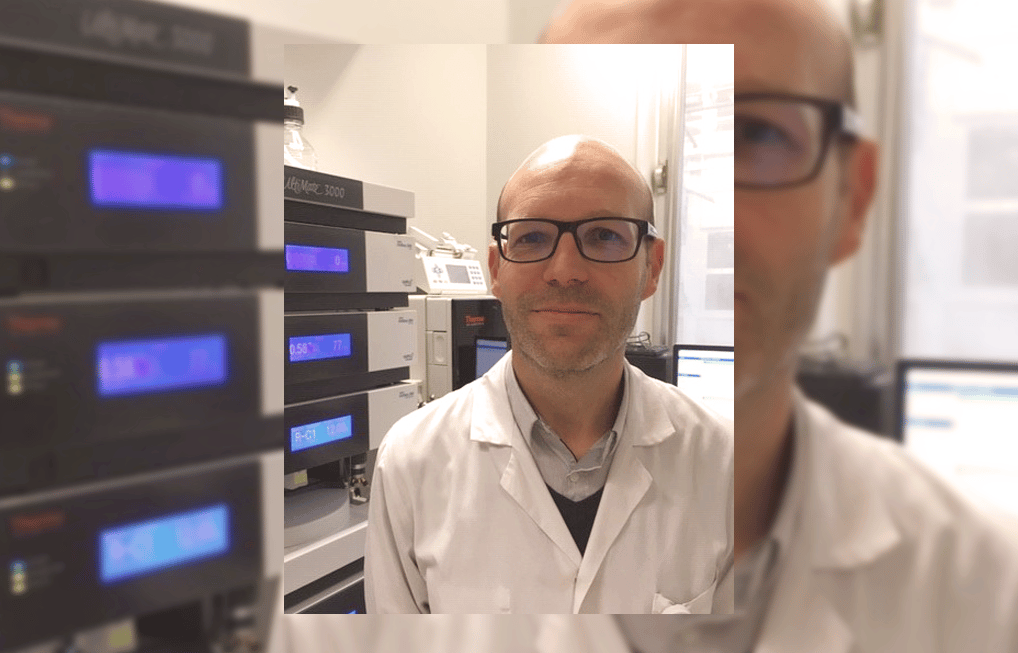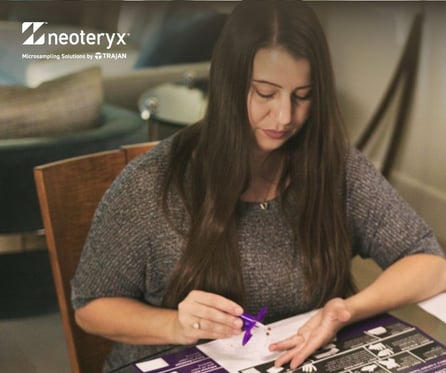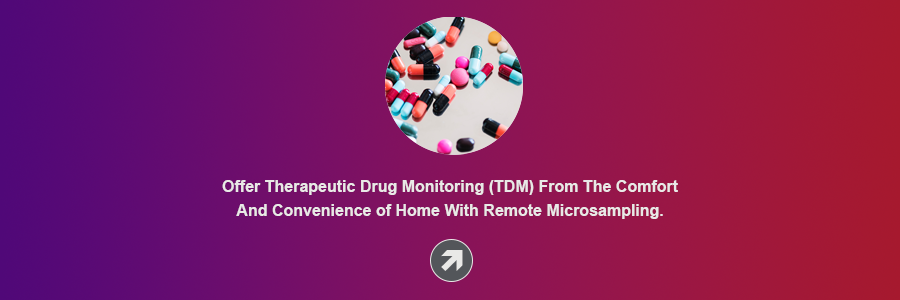Share this
microsampling for patients on therapeutic drugs: Dr. Lemaitre
by Neoteryx Microsampling on Oct 30, 2023 2:58:35 PM

For this episode of the Microsamplify Podcast from Neoteryx, we spoke with Dr. Florian Lemaitre, an Assistant Professor in Pharmacology at the Rennes University Hospital’s School of Medicine in France.
In the Pharmacology Department, Dr. Lemaitre is responsible for therapeutic drug monitoring, or "TDM" of patients taking immunosuppressive and antiretroviral drugs. He is using a remote microsampling approach to TDM in an effort to keep vulnerable patients safe at home.
 Dr. Lemaitre also conducts research and has written papers on long-term monitoring of transplant patients taking tacrolimus and other medications. Currently, he is using the Mitra® microsampling device for remote patient monitoring of intracellular tacrolimus concentrations and pharmacodynamic biomarkers in liver transplant patients, among others.
Dr. Lemaitre also conducts research and has written papers on long-term monitoring of transplant patients taking tacrolimus and other medications. Currently, he is using the Mitra® microsampling device for remote patient monitoring of intracellular tacrolimus concentrations and pharmacodynamic biomarkers in liver transplant patients, among others.
Neoteryx: Hello Dr. Lemaitre, and welcome to the Microsamplify Podcast! Can you tell us a little bit about yourself and the different roles you perform at Rennes University Hospital?
Dr. Lemaitre: Hi Christa, thanks for your kind invitation. Well, to answer your question, I have three main activities.
The first are my hospital duties. I am a hospital practitioner working at the pharmacology laboratory where we perform therapeutic drug monitoring, that is TDM, for patients with chronic or acute diseases.
I have general activities and, as you said, I am responsible for the TDM of immunosuppressive and antiretroviral drugs. We also perform biological diagnosis of Alzheimer’s disease, which is a very specific activity not usually seen in pharmacology labs.
Then, I am also an assistant professor at the school of medicine where I teach general and applied pharmacology. Ultimately, I am leading a research program on optimizing immunosuppressive drugs therapy for the benefit of solid organ transplant recipients.
Neoteryx: You have recently started offering your patients at Rennes Hospital an option for collecting their own blood samples at home. Can you tell us about that program and why you decided to offer your patients this alternative to traditional in-clinic blood draws?
Dr. Lemaitre: Well, the idea came from some years ago after a colleague made a short stay in the Rotterdam team in the Netherlands where she was offered to work on microsampling approaches. At this time, we were aware of these methods, but we were not really convinced that it was appropriate for TDM because of too many biases, but the volumetric microsampling approach changed everything.
So, we started developing a bioanalysis method and we validated it before offering the possibility of microsampling TDM for hospitalized and at-home patients. Remote blood collection and microsampling are particularly appropriate for patients living far from care facilities, patients with loss of vein patency, or pediatric patients.
Neoteryx: For my own understanding, what do you mean by vein patency? And can you explain more about how microsampling helps these patients and also pediatric patients?
Dr. Lemaitre: Yes, patients with loss of vein patency are patients with difficult access to veins, because they are either elderly patients, or maybe drug users. It's very hard for these patients to benefit from venipuncture, so the microsampling approach is very convenient for these kinds of patients.
/finger-stick%20Mitra%20microsampling%20close-up.jpg?width=452&height=265&name=finger-stick%20Mitra%20microsampling%20close-up.jpg) Neoteryx: So, with just a small lancet and a finger-prick that is far easier for them to collect a blood sample.
Neoteryx: So, with just a small lancet and a finger-prick that is far easier for them to collect a blood sample.
Dr. Lemaitre: Right, exactly.
Neoteryx: Can you talk further about your TDM strategy?
Dr. Lemaitre: In addition to this remote TDM strategy, we also conduct evaluations of global exposure of immunosuppressive drugs by evaluating the area under the curve, or AUC. In pharmacokinetics, the AUC describes the variation of a drug concentration in blood plasma as a function of time.
This approach to determining drug concentrations helps us understand unexpected effects, such as patients experiencing toxicities or organ rejections despite having trough concentrations within the therapeutic range.
Neoteryx: How many of your transplant recipients are using the Mitra® microsampling device for at-home blood collection, and how does it seem to be working for them?
Dr. Lemaitre: It is still a small part of our activity. For the moment around 10 patients are currently monitored with a remote microsampling approach. More than half of them are pediatric patients. The feedback is remarkable, and none of these patients have stepped back from the program. We still have some reluctance from clinicians but, in my view, it is an unstoppable story. Why would you want a venipuncture blood draw when you could have a simple finger-prick test for the same analysis?
Neoteryx: I agree, I think it is the wave of the future! Since you started providing at-home microsampling devices to patients, have you found the process to be efficient? For example, what is the timeframe from the point at which the patient mails their specimen sample to your lab, to when they receive their test results and then a follow-up consult with the care team?
Dr. Lemaitre: As we did not push for a large-scale program, it is still easy to handle. The mean time between mailing the devices and obtaining a TDM result is usually about four days. This is very convenient, as patients can perform their at-home sampling event only a few days before having their consultation with the clinician. We also provide an additional kit to patients, which can be used in case of concern about the quality of the first sample or inadequate result.
Neoteryx: In your experience thus far, how do the results from the remotely collected dried blood samples on the Mitra devices compare to the results of a standard blood test from a wet blood sample? For example, has remote microsampling revealed new information or helped you understand anything you were unable to understand before?
Dr. Lemaitre: To answer your first question, it is fairly comparable. Of course, we made several comparisons between standard blood tests and the volumetric absorptive microsampling method, and the correlation is really good!
Among several striking things that this new approach brought to light was the possibility to explain and offer solutions for complicated clinical situations. I can definitely remember the case of a patient whose renal function was worsening despite having tacrolimus trough concentrations within the recommended range.
We proposed conducting an AUC which, thanks to microsampling devices, is now almost a non-invasive procedure. We discovered that her global drug exposure was largely over the expected AUC for the measured trough concentration. A dosage adjustment guided with AUCs resulted in a fifty-five-point creatinine decrease in only two weeks!
We were so surprised by this amazing outcome and so happy to have the opportunity helping this patient.
Neoteryx: What an excellent result! Your therapeutic drug monitoring programs also include HIV patients and those who suffer from Alzheimer’s disease. Can you tell us more about the work you are doing for these patient groups and if remote microsampling might be helpful for them as well?
Dr. Lemaitre: In this field, we help clinicians maintaining the viral replication to an undetectable level in HIV patients by ensuring adequate drug exposure using TDM. The risk of drug-drug interaction is very important with these drugs, and our colleagues managing HIV patients often seek advice to deal with these issues.
Regarding Alzheimer’s disease, we measure protein biomarkers in patients' cerebrospinal fluid in an effort to confirm or invalidate the diagnosis. Of course, microsampling approaches can be helpful for HIV or Alzheimer's patients, but I would say it's not limited to these two fields: it is the real future of all TDM.
Neoteryx: Dr. Lemaitre, how has the current COVID-19 pandemic situation that we are all experiencing changed how you approach your work—either with your patients, your students, or in the lab?
Dr. Lemaitre: Well, it is a time for remote work as well! Since the first lockdown we have had to change our organization. Most of the research programs have been halted and the educational program has been converted online.
For transplant recipients, the follow-up, including the immunosuppressive drugs TDM, has been transferred to private analysis laboratories for them to avoid being infected during their hospital stay.
I think the pandemic acted as a trigger for everyone to realize that microsampling in biology can be a key driver in such situations.
Neoteryx: Yes, we are hearing that from a lot of people we have spoken to. What are your aspirations in the future for therapeutic drug monitoring?
Dr. Lemaitre: We are now planning to extend the remote TDM program to every liver transplant recipient followed by our institution. That means fourteen hundred patients living in an area covering roughly a quarter of France. This is a huge challenge to offer patients the TDM expertise of a very specialized unit directly at-home.
We hope for the support of our regional health agency and the French Ministry of Health for this very ambitious project.
Neoteryx: That is an ambitious project and we hope you get that support as well! Thank you so much for taking the time to talk to us about your work, Dr. Lemaitre. We wish you continued success with your research and your programs that offer remote sample collection for therapeutic drug monitoring!
Image Credits: Rennes University Hospital’s School of Medicine, Trajan, Neoteryx
Share this
- Microsampling (206)
- Research, Remote Research (119)
- Venipuncture Alternative (105)
- Clinical Trials, Clinical Research (83)
- Mitra® Device (73)
- Therapeutic Drug Monitoring, TDM (51)
- Dried Blood Spot, DBS (39)
- Biomonitoring, Health, Wellness (30)
- Infectious Disease, Vaccines, COVID-19 (24)
- Blood Microsampling, Serology (23)
- Omics, Multi-Omics (21)
- Decentralized Clinical Trial (DCT) (20)
- Specimen Collection (18)
- Toxicology, Doping, Drug/Alcohol Monitoring, PEth (17)
- Skin Microsampling, Microbiopsy (14)
- hemaPEN® Device (13)
- Preclinical Research, Animal Studies (12)
- Pharmaceuticals, Drug Development (9)
- Harpera Device (7)
- Industry News, Microsampling News (5)
- Antibodies, MAbs (3)
- Company Press Release, Product Press Release (3)
- Environmental Toxins, Exposures (1)
- July 2025 (1)
- May 2025 (1)
- April 2025 (2)
- December 2024 (2)
- November 2024 (1)
- October 2024 (3)
- September 2024 (1)
- June 2024 (1)
- May 2024 (1)
- April 2024 (4)
- March 2024 (1)
- February 2024 (2)
- January 2024 (4)
- December 2023 (3)
- November 2023 (3)
- October 2023 (3)
- September 2023 (3)
- July 2023 (3)
- June 2023 (2)
- April 2023 (2)
- March 2023 (2)
- February 2023 (2)
- January 2023 (3)
- December 2022 (2)
- November 2022 (3)
- October 2022 (4)
- September 2022 (3)
- August 2022 (5)
- July 2022 (2)
- June 2022 (2)
- May 2022 (4)
- April 2022 (3)
- March 2022 (3)
- February 2022 (4)
- January 2022 (5)
- December 2021 (3)
- November 2021 (5)
- October 2021 (3)
- September 2021 (3)
- August 2021 (4)
- July 2021 (4)
- June 2021 (4)
- May 2021 (4)
- April 2021 (3)
- March 2021 (5)
- February 2021 (4)
- January 2021 (4)
- December 2020 (3)
- November 2020 (5)
- October 2020 (4)
- September 2020 (3)
- August 2020 (3)
- July 2020 (6)
- June 2020 (4)
- May 2020 (4)
- April 2020 (3)
- March 2020 (6)
- February 2020 (3)
- January 2020 (4)
- December 2019 (5)
- November 2019 (4)
- October 2019 (2)
- September 2019 (4)
- August 2019 (4)
- July 2019 (3)
- June 2019 (7)
- May 2019 (6)
- April 2019 (5)
- March 2019 (6)
- February 2019 (5)
- January 2019 (8)
- December 2018 (3)
- November 2018 (4)
- October 2018 (7)
- September 2018 (6)
- August 2018 (5)
- July 2018 (8)
- June 2018 (6)
- May 2018 (5)
- April 2018 (6)
- March 2018 (4)
- February 2018 (6)
- January 2018 (4)
- December 2017 (2)
- November 2017 (3)
- October 2017 (2)
- September 2017 (4)
- August 2017 (2)
- July 2017 (4)
- June 2017 (5)
- May 2017 (6)
- April 2017 (6)
- March 2017 (5)
- February 2017 (4)
- January 2017 (1)
- July 2016 (3)
- May 2016 (1)
- April 2016 (2)



No Comments Yet
Let us know what you think